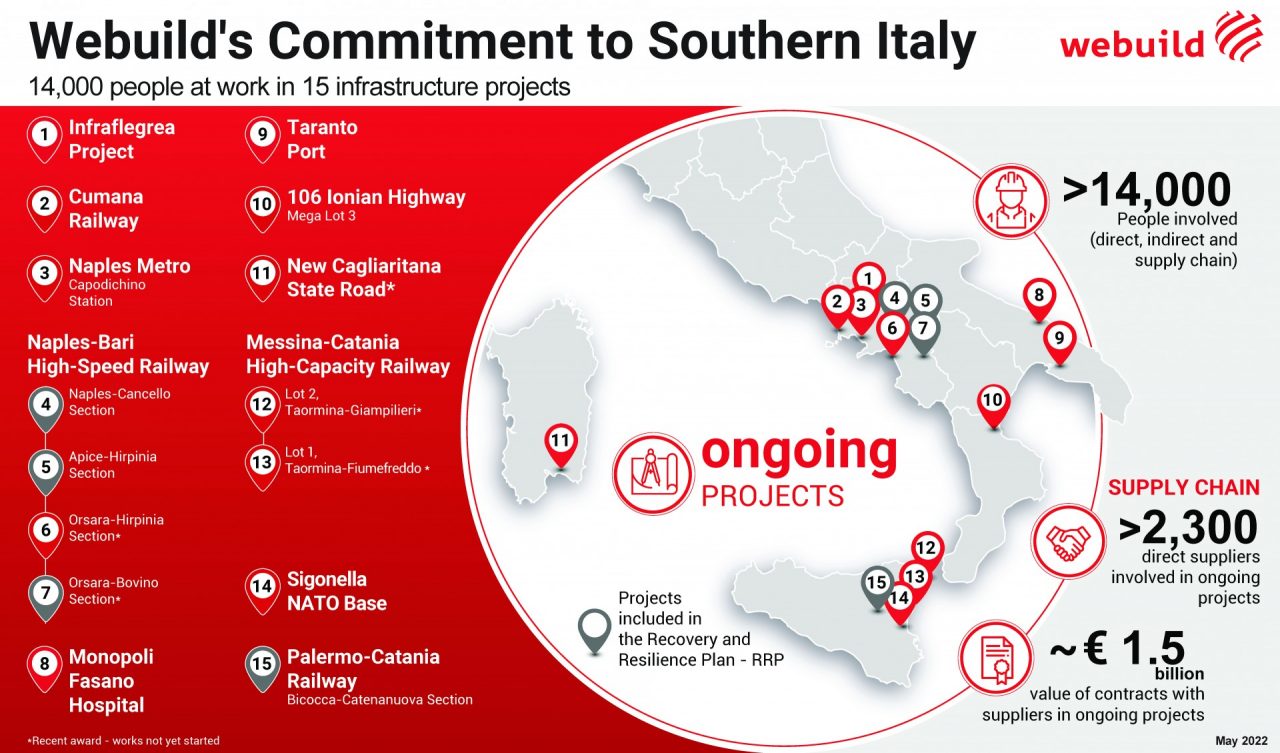Time and space, as Albert Einstein taught us, are relative. Today, this is a perfect framework for understanding a new generation of infrastructure that cuts back on time and ultimately “reduces space.” A few years from now, moving between Turin and Genoa will take just one hour, instead of one hour and 40 minutes now; a trip between Genoa and Milan will fall to one hour from 90 minutes; moving between Naples and Bari will take two hours instead of three hours and 35 minutes; and between Palermo and Catania, two hours instead of three.
Once the major high-speed and high-capacity train projects are complete, connection times across Italy will shrink significantly by fostering a sustainable transportation model and reducing both congestion and pollution. Webuild Group is involved in many of these projects, from Sicily to the Brenner Pass.
This is the future envisioned by Ferrovie dello Stato, the state-owned railways group belonging to the Italian Ministry of Economy. The FdS manages rail transport and part of the dense road network up and down the Italian peninsula.
FdS released a 10-year (2022-2031) business plan that will go toward modernising Italy’s rail transport network. And it’s not just the high-speed trains that will be affected: local lines and those that cross major cities, including Rome, Milan, Naples, Genoa, and Florence, will also benefit.
Faster trains, shorter distances
Reducing travel time, alongside making sustainable transport more readily available, is one of the top priorities for Italian development over the next few years. The Draghi government is supporting this goal through the rail infrastructure investments laid out in the PNRR (National Recovery and Resilience Plan).
The Ferrovie dello Stato’s business plan aims to foster this transformation through a 10-year. Funds will be divided across areas including extraordinary maintenance, technologies, regional networks, port/interport connections, routes of national interest, safety, tourist lines, metropolitan cities and airport connections.
According to the Group’s calculations, once the plan is fully operational, Italy’s rail capacity (in terms of train numbers and kilometres covered) will increase by 20%, significantly reducing travel time to major Italian cities. Naples, Bari, Rome, Milan, Turin, and Genoa are all set to benefit from the high-speed rail projects underway today, from the Terzo Valico dei Giovi to Naples-Bari.
A return to local transport and development of urban centers
High-speed rail remains an important development asset for Italian mobility, but investments in local transport will also be substantial. On the one hand, local governments, supported partially by state funds, are aiming to build new metro lines in major cities – in Milan, there’s the M4 underway, in Rome, the Metro C. But in addition, the Ferrovie dello Stato’s business plan takes aim at developing regional routes and launching new projects specifically designed to increase sustainable urban mobility.
Sustainability remains the guiding principle in rail development projects, as FdS CEO Luigi Ferraris confirms: “Climate change, with its impact on infrastructure, is making the environmental question ever more relevant. Innovation and the growing role of digital and connectedness in infrastructure are among the main inspirations for future action. The ambition to grow the system is inextricably tied to the development of new specific skills and related training. The urban centers, which we increasingly need to be able to reach, are the nerve center of the economy, as well as of the mobility ecosystem at the local level.”
Transport: a new tool for reviving the South
Taking the investment route is the best recipe for territorial development. Large-scale works under construction will be coupled with investment in the fleet, an essential tool for improving the general travel experience. Forty-six high-speed trains, 34 Intercity trains and 495 regional trains will be purchased in the coming years to accomplish this.
“The goal,” Ferraris said, “is to transport people and goods by creating simple, interconnected, safe mobility that respects the environment and quality of life, also in part due to increased energy independence.”
A natural byproduct of all this will be job creation and territorial growth. Today in the south of Italy, 14,000 people work in Webuild-managed construction sites, alongside a chain of 2,300 supplier companies with contracts worth around €1.5 billion. This is a quiet but steady workforce committed to completing strategic works such as the Naples-Bari high-speed rail link, the Palermo-Catania high capacity or even the new Jonica highway.
This is the road to development – and rail transport will be one of its best bets for success.


